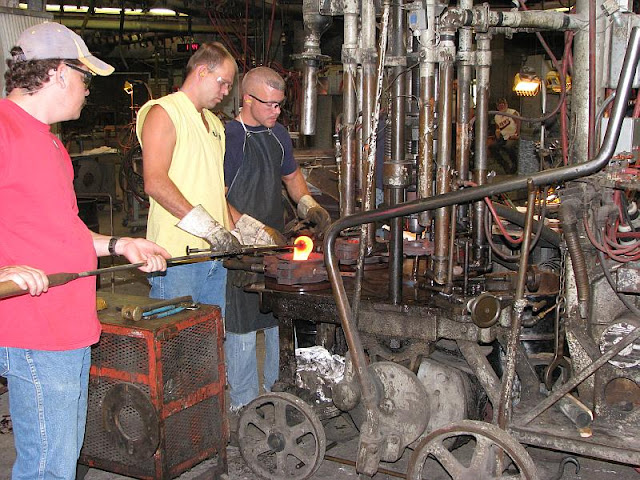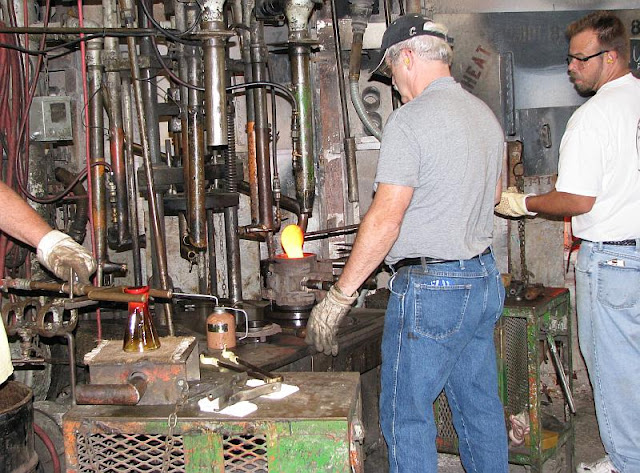Tour of Fenton Art Glass Factory
Williamstown, WV
Oct. 13, 2008
My video on You Tube shows these processes better than I am able to show in pics. Video like address after last pic.
Williamstown, WV
Oct. 13, 2008
My video on You Tube shows these processes better than I am able to show in pics. Video like address after last pic.
Founded in 1905 - by brothers Frank & John Fenton, its the largest manufacturer of handmade colored glass in the US, and the company is renowned for innovative glass colors as well as hand-painted decorations on pressed and blown glassware.
 The company is run today by third and fourth generation Fenton family members.During peak years, Fenton had as many as 560 employees. Today's downsized, restructured Fenton Glass Company has only about 120.
The company is run today by third and fourth generation Fenton family members.During peak years, Fenton had as many as 560 employees. Today's downsized, restructured Fenton Glass Company has only about 120. The raw materials of glass (silica sand, soda ash & lime) are called a batch. Approximately 71% of a batch of glass is silica sand. 14 ingredients are used in making glass as explained before the tour.
The raw materials of glass (silica sand, soda ash & lime) are called a batch. Approximately 71% of a batch of glass is silica sand. 14 ingredients are used in making glass as explained before the tour. Glass is blown slightly creating air pocket in center, then placed on rollers at right corner to keep it rotating until needed for next step of making large milk-glass vases.
Glass is blown slightly creating air pocket in center, then placed on rollers at right corner to keep it rotating until needed for next step of making large milk-glass vases.The melting temp for a batch of glass averages 2500 degrees F.
 The glass is next placed into a mold for several seconds coming out as a large globe of milk glass, bumps and all. Look at the glow of furnaces all around!
The glass is next placed into a mold for several seconds coming out as a large globe of milk glass, bumps and all. Look at the glow of furnaces all around!No two Fenton pieces are exactly the same.
 Here the vase has been passed to a man who shapes the open end, then places it in a crimper on the floor at his feet after which he shapes it still further.
Here the vase has been passed to a man who shapes the open end, then places it in a crimper on the floor at his feet after which he shapes it still further.Pieces not deemed "perfect" at this time are discarded into large metal drums.
 These men are making small purple candy dishes with ruffled edges. The melted glass is put into the mold and then under the press.
These men are making small purple candy dishes with ruffled edges. The melted glass is put into the mold and then under the press.Molds for glass making are made of cast iron.
 The lever of the press is pulled forward, the mold removed, the purple dish removed and set on a tray for transfer to the cooling ovens. Four men each do one step of this process.
The lever of the press is pulled forward, the mold removed, the purple dish removed and set on a tray for transfer to the cooling ovens. Four men each do one step of this process. To cool glass pieces they use an 'annealing lehr'. The machine is like a big pizza oven where finished pieces are placed to slowly cool them.
To cool glass pieces they use an 'annealing lehr'. The machine is like a big pizza oven where finished pieces are placed to slowly cool them. This is the first step in making ruffled edge vases. That's one of the vases at the left in the prongs which looks like a drinking glass at this point.
This is the first step in making ruffled edge vases. That's one of the vases at the left in the prongs which looks like a drinking glass at this point. 


No comments:
Post a Comment